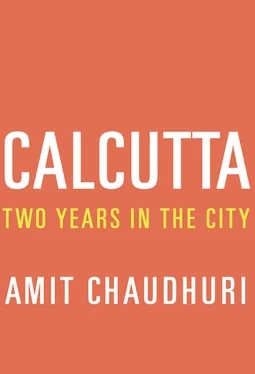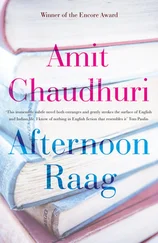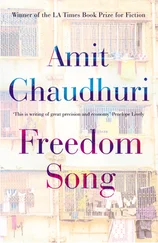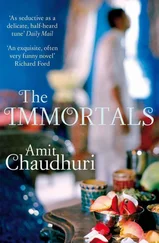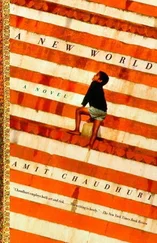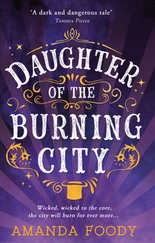Conventionally, the beginnings of this putative Renaissance might be fixed either at 1814, when Raja Rammohun Roy founded the Atmiyan Sabha with reform in mind, especially on behalf of Hindu widows, who couldn’t, at the time, remarry; or in 1828, when he founded the Brahmo Samaj, a unitarian sect that refuted Hinduism’s polytheism, turning instead towards an immanent, formless— nirakaar —divinity apparently first intuited by humans in the Upanishads and Vedas. But the full-blown effects of this turn would only become palpable from the 1860s onward. It’s clear, then, that the Bengalis, in their transition into self-consciousness, went down routes opened up for them by now relatively obscure Orientalist scholars, like the Welshman William Jones, translator of, among other writers and texts, the fourth-century court poet Kalidasa, and the Frenchman Abraham Hyacinthe Anquetil-Duperron, translator of the Upanishads. For these Europeans, the unusual ferment of the time — the late eighteenth century — that brought them into contact with Indian Brahmins and, through them, Indian antiquity had a particular significance: with these hoary, beautiful texts they established the extraordinary lineage of the East, and also proved that the story of humanism — authored by the European Enlightenment — had an ancient and important setting in India, and not just, as had been presumed, in Greece and Rome. For Indians like Roy and Tagore, though, these texts didn’t only represent the glory of the Indian past (which they did), or the Indian’s place in the larger world (which they did too); they pointed out a way to what India, and they themselves, would be in the foreseeable future. Roy could have been content with the wonder and prestige of Indian antiquity; his great innovation, whether he knew it or not, was to make the Upanishadic heritage a basis and pillar of the secularism we’ve come to take for granted, to read it, in effect, as a contemporary resource that showed Indians how to be modern. Tagore began to perform a similar innovation with the Sanskrit poet Kalidasa, and with that same Upanishadic tradition, from the 1890s onward: to regard them not just as “our great tradition,” as dead heritage, but as essential to fashioning the modern poem and literature.
We’ve lost our way. Where exactly is Shobhabazar? We’re in Shyambazar, lurching forward steadily in the congestion —Dada, in which direction is the Naba Jiban Nursing Home? And, excuse me, Dada, did the Bengal Renaissance really happen? Could you point out its signs?
By the 1960s and 1970s, Marxist critics in Calcutta were ferociously, scathingly, disputing the notion of the Renaissance in Bengal. It was hardly a genuine renaissance, they said; to call it one would be an act of hubris. Their main quarrel was with its bhadralok context: its exclusion of the poor and the minorities — a charge that couldn’t be ignored. As a consequence, the idea of the Bengal Renaissance — and the bhadralok himself — has been much reviled: most often by the bhadralok, in an act of expiation.
The English, anyway, had never noticed its existence, though it happened under their noses. For the Englishman, both Indian modernity and the Indian modern were invisible. In a sense, then, Calcutta, to him, was invisible. Kipling, writing in the midst of the Renaissance, populates his magical stories of India with talking wolves, tigers, cheetahs, and orphan Indian children who have no trouble communicating with animals. No one would know, reading Kipling, that Bagheera, Sher Khan, and Mowgli are neighbours and contemporaries of the novelist Bankimchandra Chatterjee and the poet Michael Madhusudan Dutt. In Kipling’s universe — and, to a considerable extent, in Britain’s — the Renaissance, and Bengali and Indian modernity, might as well have never happened in India’s uninterrupted, fabulous time.
This was not a renaissance overseen and funded by potentates, as the Italian Renaissance was. It had no Lorenzo de’ Medici. It burgeoned, incongruously, in the time of Empire, when the imperial view of culture — when there was one at all — was busy with other things. Which is why it has no monuments; which is why, when I go northward, to Mini mashi’s flat, or elsewhere, or, as we did that afternoon, in search of the Naba Jiban Nursing Home ( naba jiban , “new life,” itself unwittingly echoing the resurgent naba jagaran), the only really grand official buildings are the lapsed colonial institutions on Central Avenue — such as the School of Tropical Medicine — still extant, and symbolic. When, on those journeys, you look for that so-called Renaissance’s great buildings, you, of course, see none.
When people visit me in Calcutta, I take them not to see landmarks, but people’s houses. These might be the ones found in charming clusters in Bakul Bagan, Paddapukur, or Bhowanipore, built in the twenties, thirties, and forties; or near the Hooghly, in marginal Kidderpore; or up north, where the ancestral mansions are, and which even I haven’t properly explored. Each house differs from the other, but there’s a family resemblance: the green French windows with slats, the intricate cornices on the balconies, the red stone floors, the stairs rising to the wide terrace where clothes are hung to dry and children hover, and, if the house came up after Independence, the wavy or floral grilles, the flecked tiles, the art-deco-type windows with frosted panes. There are no other monuments in Calcutta. When I look at these houses, I feel excited, as I might when rereading one of James Joyce’s stories; the pleasure of being surprised, even after repeated encounters, by the new. And the modern is perennially new, no matter what state it’s in, and even when it’s being dismantled — as many of these houses are, by property scamsters called “promoters.”
This renaissance wasn’t the renaissance of an empire, but of a home-grown bourgeoisie largely unacknowledged by the imperial sovereign; so its theme and subject isn’t grandeur, as often seems to be the case in the European Renaissance, in the resplendent, glowing paintings of Titian, in Michelangelo’s gigantic, looming, perfectly buttocked David, but the everyday and the desultory, such as you see in the films of Ritwik Ghatak and Satyajit Ray. This renaissance is, in many ways, a refutation of that earlier, better-known one, with its epic pretensions. Its protagonist isn’t the soldier on horseback, or the gods, or the regent in the hall or garden; it is really the loiterer. Jean Renoir sensed this on his visit to this city in 1949, when he remarked, when describing Calcutta, that “all great civilisations are based on loitering.”
In the Jewish Museum in Hallesches Tör in Berlin, I realised, on the second floor, that modern man, twentieth-century man — in all his or her unimpressiveness and unintended comedy, in his or her preoccupation with shopping, the arts, the stock market, keeping diaries, borrowing books, going to the cinema, reading newspapers — might be the subject of a memorial, and have these enthusiasms recorded and collections and possessions displayed. That museum, of course, commemorated the sudden, enforced passing of a culture; it paid tribute, on the second floor, to an abortive but, in the end, ordinary world. I was accustomed, in museums, to reluctantly examining the vestiges of great civilisations — portraits of dukes and princes, pictures of dead pheasants in the kitchen, a comb that belonged to an empress, a stone from a palace, a bust of the Buddha or of Zeus. I say “reluctantly” because I’d never actually been that interested in the crumbling of bygone panoramas, or in the historical or canonical; and it was in the Jewish Museum, on the second floor, that I understood that it was the banality of modern man that gave me most pleasure and most moved me. This explains, to a certain extent maybe, why I introduce visiting friends to neighbourhoods in Calcutta when they ask to see the city. It’s here that the particular history I’m speaking of resided, and still persists in an afterlife, and where it will — as is already evident (and probably to the relief of all concerned) — eventually vanish.
Читать дальше
